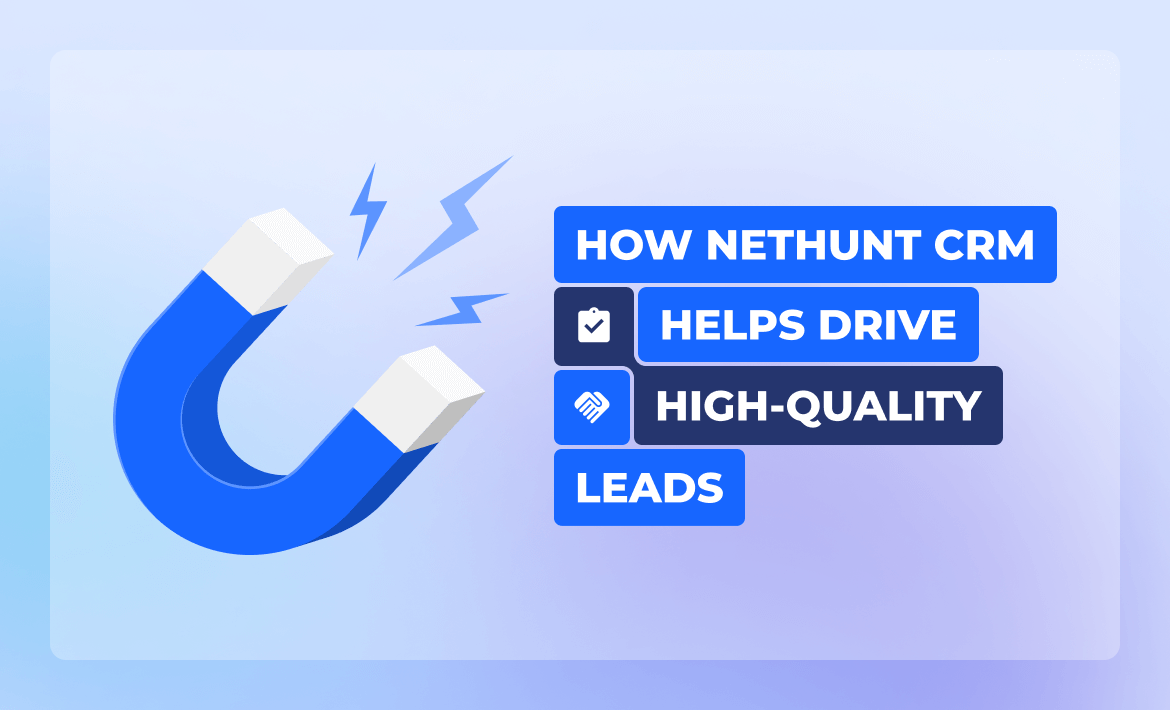NetHunt CRM lead generation: capture, nurture, and automate to boost conversions.
You need new clients to grow your business. But before they become paying customers, you need leads — and the more, the better.
In the good old days, you’d use cold calls or newspaper ads. However, in today’s oversaturated market, these traditional methods simply won’t cut it. Instead, automated omnichannel lead generation offers a more effective way to gain attention and boost sales.
And among a dozen popular lead generation tools available, a CRM stands out as the most convenient and efficient tools that you can start using from day one. Here, we’d use NetHunt CRM as an example of a CRM system that can boost your lead generation efforts.
What is lead generation CRM and how can it help you?
Lead generation is the process of attracting interested prospects and nurturing them until they become paying clients.
Think of it like dating. First, you bump into a stranger and swap a few words. If you’re lucky, you exchange names and numbers. Over time, you build a relationship by texting, chatting, and eventually setting up a date.
Of course, you can’t juggle hundreds of names and numbers in your head. That’s where a lead generation CRM comes in. It collects data from all the places your prospects find you (email, social media, or an ad) and helps you keep track of all the leads.
A CRM stores all potential customer data, monitors your interactions, and enables you to nurture relationships until they are ready to convert. Best of all, a CRM for lead generation makes your life easier by automating routine tasks, like setting up drip campaigns, sending follow-up emails, and generating sales performance reports.
So, why do you need a CRM to generate and prospect leads?
Can you get leads without a lead gen CRM? Sure! Should you? Not really.
It’s a case of quality and quantity.
While a CRM alone won’t instantly make your business famous or flood you with leads, it ensures you never miss a sales opportunity. By managing leads effectively, a CRM helps increase your conversion rates, turning prospects into paying customers.
CRM goes beyond simply tracking leads on a spreadsheet. It stores detailed information about every lead — from their first interaction with your business to the final sale — and logs every touchpoint along the way. This comprehensive data is essential for crafting targeted communication to convert hesitant prospects.
Even more crucially, a CRM automates many marketing and sales tasks, making it easy to manage thousands of leads at scale. It handles thousands of records without losing a single one, unlike a sales manager wading through the spreadsheet row after row.
So, though a lead generation CRM software is a big investment, it’s one that pays off and grows your business.
Choose NetHunt CRM to generate leads and automate nurturing
Let’s see what makes NetHunt CRM the top leads generation system and how it can benefit your business.
Capture leads on your website, social media, or anywhere else
How to generate leads? With NetHunt CRM, every lead source is at your fingertips. Thanks to our omnichannel toolset, you can:
- Generate new CRM records directly from your Gmail inbox
- Capture call details on the go and track the lead through the pipeline
- Create detailed company and contact records from messengers like WhatsApp, Instagram, etc
- Capture contact details and conversation specifics with messengers like Whatsapp or Telegram and live chat integrations + communicate with leads from all channels right in the CRM system
- Capture leads from website forms and nurture them
What do you do with all these contacts and details? Use NetHunt CRM to store, segment, and manage leads, turning them into prospects and paying customers.
Divide and conquer: segment leads to close more deals
Personalization is all you hear about these days in marketing circles. Every lead expects you to read their mind and understand their unique wants and needs. And that’s where segmentation comes into play.
With NetHunt CRM tools for lead generation, you can have a bird’s eye view of all contacts and companies and segment them for targeted marketing and sales campaigns. For example, you can set up different email campaigns for various markets or tailor them to the prospects’ roles within their organizations to prioritize leads better.
NetHunt CRM makes segmentation easy with filters and saved views, which you can use to set up automatic workflows or drip campaigns. Here are a few ideas for lead segmentation you can implement with NetHunt:
- Use demographics, like country, age, gender, or title, to target specific groups. For example, write unique offers for managers and employees, showcasing your benefits for each position.
- Analyze lead engagement with your emails, or social media to craft unique campaigns. Let’s say your CRM shows you that some of your prospects have never opened your messages. In this case, you’ll need to work out an eye-catching email subject.
- Learn where prospects are in their buyer journey and spur them into converting. For instance, if they’re interested but unwilling to pay for the product now, offer a free trial to entice the prospects.
Lead segmentation is a trial-and-error process, but NetHunt CRM lets you experiment and find the right approach.
Find pipeline bottlenecks and track missed opportunities
If you think you can’t track every deal and follow every dollar, think again.
With NetHunt CRM, you don’t have to run endless meetings and listen to doctored reports. Instead, you can set up custom pipelines and adjust views to track the sales team or individual manager’s performance. NetHunt CRM also helps you assess product sales or campaign success in multiple locations.
With this detailed view of everything happening with your sales team, you’ll spot the best performers and most lucrative deals along with underperformers and blocked deals.
Nurture leads to close deals
Instead of manually tracking each contact and interaction, build complex workflows with NetHunt’s ultra-customizable objects. For instance, you can use NetHunt CRM to set up drip campaigns and automated nurturing sequences for each target segment. Plus, mix in different communication channels to cover all bases.
You remember that you can receive and send messages within the CRM to all your leads regardless of the communication channel, right?
Make better decisions with customized reports
Watching the pipeline in real time helps you take immediate action if the deals are lagging or need extra attention. Many different types of reports help analyze overall trends and find weaknesses in your marketing and sales processes. Besides, you can customize the reports to focus on individual performance or revenue won or lost.
By the way, you can also use reports for forecasting. It’ll help you plan future growth or expansion and make manufacturing or HR decisions. And integration with Data Studio is great for creating interactive reports and sharing them with your whole team, customers, or the world.
Maximize your resources with lead nurturing automation
How big is your marketing and sales team? And how much time do they waste on busy work, like refreshing inboxes or writing follow-ups?
NetHunt CRM takes over all the routine mechanical tasks and frees up your resources. Our CRM can automate the lead generation workflow, from assigning leads to managers to sending follow-up emails and adjusting lead status in response to their interactions. It only takes a few days to write email templates and set up automatic email campaigns and workflows you can use for months to come.
Generate leads or fail: What leads mean to your business
But is it worth the effort? You can just post random ads online and wait for the customers to mob you, right? Unfortunately, we’re all immune to most ads, and getting anyone to click on a link is nearly impossible. That’s what makes leads so valuable.
More leads mean…
- More sales. Even if your conversion rate remains the same, more leads will always result in improved sales (and revenue).
- Lower expenses. Focusing on leads instead of random strangers will keep your marketing and sales teams on budget.
- Better ROI. With lower expenses and more sales, the return on investment of your marketing and sales efforts will also inevitably rise.
- Improved brand awareness. Once lead nurturing efforts pay off, you’ll start getting new leads through word of mouth, thanks to the positive vibe you generate.
- Faster business growth. CRM and lead generation efforts are especially noticeable in the long term. All the goodwill and extra cash will help your business grow faster and gain momentum in the niche.
And NetHunt is the best CRM for lead generation, as we’ve demonstrated today.
Common lead generation mistakes to avoid
Everyone makes mistakes with lead generation. Recognizing and correcting them is what matters. Here are a few common red flags to avoid in your marketing and sales processes:
- Poor lead segmentation. Keep the segments too large, and your personalization efforts will be wasted. Make them too small, and you’ll spend all your time working out custom campaigns for each segment. If in doubt, start with two or three buyer personas and work your way up if necessary.
- Ignoring leads’ pipeline stages. Some leads may be ready to purchase right away, but others need some TLC from your marketing team. Have materials and workflows ready for leads across different pipeline stages to boost your conversion rate (and sales!).
- Missing data-driven insights. Lead nurturing isn’t a one-and-done deal. It must evolve and improve over time based on the data you get from the dashboards and sales reports. Otherwise, you’ll fall behind and let the competition beat you.
- Lack of consistent follow-ups. Prospects often need multiple touchpoints before making a decision, and failing to nurture them after an initial interaction can result in lost opportunities. Implement follow-up strategies using your CRM. Automated email sequences, reminders for your sales team, and task assignments can ensure that no lead is forgotten.
- Overlooking the importance of lead re-engagement. Not all leads will convert on the first attempt, but that doesn’t mean they’re a lost cause. Leads can grow cold over time, and failing to re-engage them is a missed opportunity to bring them back into the funnel. Use your CRM to identify inactive leads and create targeted re-engagement campaigns.
Final thoughts
As we’ve already proven in the article, lead generation is the fastest and most effective way to boost sales, lower expenses, and grow your business. But for that to happen, you need the right tool.
Lead gen and CRM come hand in hand. NetHunt CRM is made to store all those lead details in one place and automate routine tasks. You can visualize your sales pipelines, automatically assign leads to managers, set up drip nurturing campaigns, and generate reports. All to encourage your leads to turn into customers.
FAQ
What is lead generation?
Lead generation is the process of turning people interested in your businesses into potential future customers. Common lead generation tools involve quality content, polls, promotions, free demos, etc.
What's better for lead generation: an email marketing tool or a CRM?
CRM is better for lead generation than an email marketing tool. A CRM hosts all data on contacts, partners, sales managers, and their performance. Advanced CRMs include omnichannel communication, unlike email marketing tools, and offer multiple automation and reporting features.
What are the sales lead generation stages?
Attract, capture, nurture, and convert are the four stages of sales lead generation, but there are other interpretations. At the first stage, generate interest and brand awareness. Next, offer value in return for leads’ details. Once you have their contact info, you can nurture leads before converting them into customers.
Table of Contents
Crack the sales formula with CRM Lab
Twice a month, receive actionable CRM content to your inbox.


